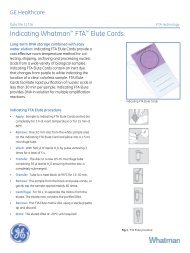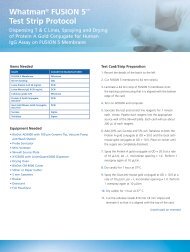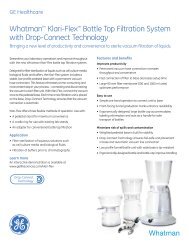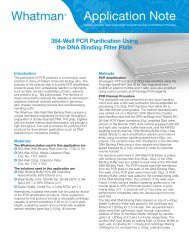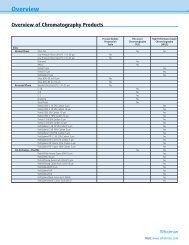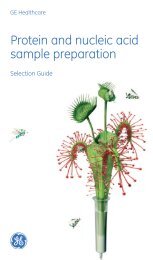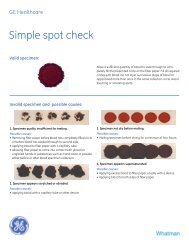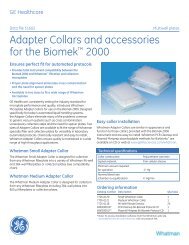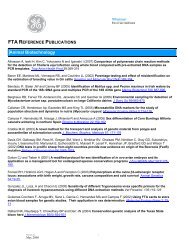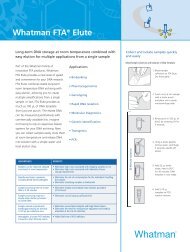MicroCaster - A Tool for Building Protein Microarrays - Whatman
MicroCaster - A Tool for Building Protein Microarrays - Whatman
MicroCaster - A Tool for Building Protein Microarrays - Whatman
Create successful ePaper yourself
Turn your PDF publications into a flip-book with our unique Google optimized e-Paper software.
<strong>MicroCaster</strong> <br />
A <strong>Tool</strong> For <strong>Building</strong> <strong>Protein</strong> <strong>Microarrays</strong><br />
Tom Owen, Debbie English, Lara Dowland and Breck Parker<br />
INTRODUCTION<br />
Much of today’s high visibility, cutting-edge microarray technology<br />
entails the use of high-throughput systems such as sophisticated<br />
robotics that require large capital expenditures. There is a large<br />
population of researchers who do not have access to robotic arrayers<br />
and who want to screen or study a small collection of molecules.<br />
As an alternative to robotic arrayers, the <strong>MicroCaster</strong> can be<br />
used as a tool <strong>for</strong> hand-arraying molecules onto FAST ® Slides in<br />
a microarray <strong>for</strong>mat.<br />
The use of nitrocellulose as a matrix to immobilize nucleic acids<br />
targeting the hybridization of their complementary sequences has<br />
been well documented in the literature. 1 It has served as a key tool<br />
<strong>for</strong> molecular biologists who have employed it in Southern, Northern,<br />
and Western blotting procedures. These procedures, which have been<br />
modified and miniaturized to create microarrays, continue to <strong>for</strong>m<br />
the backbone of scientific discovery. 2-11 Microarray technology<br />
allows researchers to screen large libraries of molecules such as<br />
DNA and proteins in time-spans that previously would not have been<br />
feasible. 12,13 This technology provides the tools necessary to begin the<br />
process of deciphering the functional aspects of sequences buried<br />
within the human genome. 14<br />
Construction of a microarray requires that biomolecules be<br />
immobilized on a matrix in an ordered fashion. The molecules<br />
must be available <strong>for</strong> hybridization or binding to their labeled target<br />
molecules in order to elicit the detection of target elements. DNA<br />
microarrays have engendered tremendous interest since the first<br />
experiments were published in 1995. This is due in part to the ease<br />
of printing microarrays using the vast amount of available sequence<br />
data as well as DNA’s uniquely homogenous nature and chemical<br />
stability. <strong>Protein</strong> microarrays, on the other hand, have only recently<br />
been introduced into the researcher’s toolbox. They present many<br />
challenges to the researcher because proteins are heterogeneous<br />
in chemical composition and present a wide range of molecular<br />
stabilities and binding affinities. The methods used to prepare<br />
protein microarrays are constantly evolving to provide scientists with<br />
improved tools <strong>for</strong> protein discovery. <strong>Whatman</strong> Schleicher &<br />
Schuell’s nitrocellulose-based FAST Slide is being used<br />
extensively to produce several different types of protein arrays,<br />
e.g., arrays <strong>for</strong> enzyme-substrate, protein-protein, antibody-antigen<br />
and drug-protein interaction studies. 15,16<br />
The work presented in this application note demonstrates the ability<br />
of the <strong>Whatman</strong> Schleicher & Schuell <strong>MicroCaster</strong> to successfully<br />
array proteins onto FAST Slides. For the purpose of demonstration,<br />
we prepared a titration series of antibodies <strong>for</strong> use in a cytokine<br />
expression analysis assay. Using a cytokine stimulation protocol from<br />
Moody et al., 17 human THP-1 leukemia cells were activated with a<br />
cytokine-stimulating agent. Complementary binding of expressed<br />
cytokines to monoclonal capture antibodies arrayed onto FAST<br />
Slides was demonstrated. 16 We show that protein arrays produced<br />
with the <strong>MicroCaster</strong> can be processed using fluorescent, chemiluminescent<br />
and colorimetric detection methods.<br />
METHODS<br />
<strong>MicroCaster</strong> Preparation and Cleaning Protocol<br />
Prior to use, the <strong>MicroCaster</strong> hand tool and indexing unit/slide holder<br />
were cleaned with a 5% bleach solution. The entire unit was subsequently<br />
dried be<strong>for</strong>e using. The 8 solid replicator pins, which are<br />
0.457 mm in diameter and anchored in the hand tool, must be<br />
cleaned and conditioned be<strong>for</strong>e printing an array. To clean and<br />
condition the pins, 3 consecutive shallow petri dishes were filled 3/4<br />
full with sterile water, followed by a single dish 3/4 full with 100%<br />
ethanol. The replicator pins were dipped into the first water bath and<br />
gently swirled <strong>for</strong> a few seconds (without letting the pins scrape the<br />
bottom of the dish), then transferred to the second and third water<br />
baths, each time swirling the pins in a similar motion. Finally, the<br />
pins were dipped into the ethanol bath, gently swirled, removed and<br />
dried completely with a hot air drier (hair dryer). A 1:5 dilution of<br />
<strong>MicroCaster</strong> Pin-Conditioner in sterile water was prepared and<br />
poured into a shallow petri dish until 3/4 full. The replicator pins<br />
were dipped into the conditioner up to the halfway point of the pins<br />
and transferred to <strong>Whatman</strong> Schleicher & Schuell GB002 blotting<br />
paper where the tips were gently blotted dry. This conditioning step<br />
was repeated a second time followed by hot air drying the replicator<br />
pins. A final wash series of 3 water bath swirls and an ethanol bath<br />
swirl was per<strong>for</strong>med in a similar manner as previously stated. Prior<br />
to arraying, the hand tool was maintained in a stationary, upright<br />
position on the indexing unit to prevent pin damage.<br />
Source Plate Preparation<br />
This work utilized 4 monoclonal capture antibodies to detect<br />
cytokines (IL-4, IL-8, IL-1β and ICAM-1) in untreated and<br />
lipopolysaccharide (LPS)-treated THP-1 cell lysates. The capture<br />
antibodies were diluted in <strong>Protein</strong> Array Buffer to 0.5 mg/ml, 0.25<br />
mg/ml and 0.125 mg/ml. Donkey anti-goat (DAG) antibody diluted<br />
to 0.125 mg/ml, and buffer (no protein) were used as positive and<br />
negative controls respectively. The capture antibody locations in the<br />
array are shown in Figures 1 and 2a.
Arraying Methods<br />
Two FAST Slides (single pad, 20 mm x 51 mm) were placed on the<br />
stage of the slide holder and the indexing unit was lowered into position<br />
above the slides. The entire unit was oriented with the X-axis<br />
motion pin distally located and set in the first position (farthest<br />
right), and the Y-axis motion pin distally located in the first position<br />
as well (farthest left).<br />
<strong>Protein</strong>s were transferred onto FAST Slides following the<br />
<strong>MicroCaster</strong> protocol. Briefly, the pin tool was lowered into the protein<br />
sample making sure the pin was centered within the source plate<br />
well and did not touch the well’s bottom. With a steady motion, the<br />
pin tool was removed from the well and placed in the indexing unit.<br />
The pin tool was depressed with an even, steady motion until the<br />
second stop position was reached on the indexing unit. The hand tool<br />
was then placed back into the same set of source plate wells and a<br />
duplicate array was made on the second FAST Slide. The Y-axis<br />
motion pin was moved two places every cycle until a total of six<br />
replicates were transferred.<br />
The preceding steps were repeated <strong>for</strong> each subsequent concentration<br />
set of capture antibodies. Between each concentration set, the x-axis<br />
motion pin was moved two places to the left. The pins were washed<br />
and dried between concentration sets by dipping them into the three<br />
consecutive water baths with a swirling motion followed by an<br />
ethanol wash as described in the “<strong>MicroCaster</strong> Preparation and<br />
Cleaning Protocol” section of this application note. Immediately<br />
after the ethanol wash step, the pins were put through the same<br />
series of washes a second time and hot air-dried using a hair dryer.<br />
The arrayed FAST Slides were removed from the holder, air-dried<br />
<strong>for</strong> 5 minutes, and stored at room temperature prior to processing.<br />
Cell Lysate Preparation<br />
Human THP-1 leukemia cells (ATCC, Manassas, VA) were cultured<br />
to log phase in flasks containing 50 ml of RPMI 1640/10% fetal<br />
bovine serum. One flask was treated with 5 µg/ml lipopolysaccharide<br />
(LPS; Sigma-Aldrich) in the media to induce a cytokine response,<br />
while the other flask only contained media. Both flasks were incubated<br />
<strong>for</strong> an additional 6 hours. The cells were pelleted by centrifugation.<br />
The cell pellet was washed 2 times with ice cold 1X PBS, pH<br />
7.4 and spun in a centrifuge to pellet the cells. The cells were resuspended<br />
in 1 ml of lysis buffer (1X PBS pH 7.4, 0.2%<br />
NP-40, 1mM EDTA, protease inhibitor cocktail) and subsequently<br />
vortexed. After a 15-minute incubation on ice, the lysed cells were<br />
centrifuged and the supernatants, containing the targeted cytokines,<br />
were removed and stored at -70°C until use.<br />
Detection Protocol<br />
Fluorescence: The arrayed FAST Slides were placed in sufficient<br />
<strong>Protein</strong> Array Blocking Solution cover the slides and gently agitated<br />
<strong>for</strong> 15 minutes. Following the blocking step, Incubation Chambers<br />
were attached to the slides and 725 µl of a 1:10 dilution of treated or<br />
untreated cell lysates with <strong>Protein</strong> Array Blocking Solution as the<br />
diluent was added to the appropriate slide. After completion of a<br />
4-hour incubation at room temperature, the chambers were removed<br />
and the cell lysate solutions were discarded. The slides were washed<br />
3 times with <strong>Protein</strong> Array Wash/Block Buffer <strong>for</strong> 5 minutes each<br />
and new chambers were added to the slides. A cocktail solution<br />
containing 200 ng/ml each of biotinylated IL-4, IL-8, IL-1β and<br />
ICAM-1 polyclonal antibodies in <strong>Protein</strong> Array Wash/Block Buffer<br />
was prepared and 725 µl of the cocktail was added to each of the<br />
slides. The slides were mixed and incubated <strong>for</strong> one hour at room<br />
temperature. The slides were washed three times with <strong>Protein</strong> Array<br />
Wash/Block Buffer <strong>for</strong> 5 minutes each. From this point on, the slides<br />
were protected from light to prevent photobleaching. Streptavidin-Cy 5<br />
(Amersham Biosciences) was diluted 1:5000 in <strong>Protein</strong> Array<br />
Wash/Block Buffer and added to the slides, which were gently agitated<br />
<strong>for</strong> 1 hour at room temperature. The slides were subsequently washed<br />
3 times at room temperature with <strong>Protein</strong> Array Wash/Block Buffer<br />
<strong>for</strong> 5 minutes each, and then rinsed <strong>for</strong> 2 seconds in dH 20, dried and<br />
scanned with the Perkin Elmer Scanarray 4000. ScanArray and<br />
QuantArray software from Perkin Elmer were used to capture images<br />
and to calculate specific intensities and spot morphologies.<br />
Chemiluminescence and Colorimetric Detection: The arrayed<br />
slides were placed into a sufficient volume of 1X TBS/1% casein to<br />
cover the slides and gently agitated <strong>for</strong> 15 minutes. Following the<br />
blocking step, Incubation Chambers were attached to the slides and<br />
725 µl of a 1:10 dilution of treated or untreated cell lysates with 1X<br />
TBS/1% casein as the diluent was added to the appropriate slide.<br />
After completion of a 4 hour incubation at room temperature, the<br />
chambers were removed and the cell lysate solutions were discarded.<br />
The slides were washed 3 times with 1X TBS <strong>for</strong> 5 minutes each and<br />
new chambers were added to the slides. A cocktail solution<br />
containing 100 ng/ml each of biotinylated IL-4, IL-8, IL-1β and<br />
ICAM-1 polyclonal antibodies in 1X TBS/1% casein was prepared.<br />
The cocktail solution (725 µl) was added to each of the slide chambers,<br />
mixed and incubated <strong>for</strong> 1 hour at room temperature. They<br />
were washed 3 times with 1X TBS <strong>for</strong> 5 minutes each.<br />
Chemiluminescence: Streptavidin-HRP (horse radish peroxidase)<br />
was diluted 1:5000 in 1X TBS/1% casein and added to the<br />
Incubation Chamber. The slides were gently agitated <strong>for</strong> 1 hour at<br />
room temperature. The slides were subsequently washed 3 times at<br />
room temperature with 1X TBS <strong>for</strong> 5 minutes each. Detection<br />
utilized Super Signal ® Substrate (Pierce Endogen) treatment <strong>for</strong> 5<br />
minutes followed by a 5 minute exposure to Kodak’s BioMax film.<br />
Colorimetric: Streptavidin-AP (alkaline phosphatase) was diluted<br />
1:1650 in 1X TBS/1% casein and added to the Incubation Chamber.<br />
The slides were gently agitated <strong>for</strong> 1 hour at room temperature, and<br />
subsequently washed 3 times at room temperature with 1X TBS<br />
<strong>for</strong> 5 minutes each. The slides were placed into 25 mls of BCIP<br />
substrate (Sigma-Aldrich) and gently rocked to generate a<br />
colorimetric reaction.<br />
Figure 1. Diagram detailing the components involved<br />
in standard “sandwich” <strong>for</strong>mat. For colorimetric and<br />
chemiluminescent detection substitute SA-Cy 5 with<br />
SA-HRP and SA-AP respectively.
RESULTS<br />
The cytokine antibody microarrays used in this work were printed on<br />
FAST Slides using the <strong>MicroCaster</strong> manual arrayer, screened with<br />
cell lysates, and detected with a labeled antibody in a standard<br />
“sandwich” <strong>for</strong>mat (Figure 1). The titration of each cytokine antibody<br />
was printed as a row of 12 replicates, while the control rows<br />
consisted of a combination of six positive and six negative replicates<br />
(Figure 2a). The immobilized monoclonal antibodies to IL-4, IL-8,<br />
IL-1β and ICAM-1 were used to screen untreated and LPS-stimulated<br />
THP-1 cell lysates. IL-4 cytokine was not LPS-induced and there<strong>for</strong>e,<br />
was not detected, while IL-8, IL-1β and ICAM-1 cytokines generated<br />
signals representing the induction of each cytokine (Figure 2a).<br />
The cytokine antibodies arrayed on the FAST Slide supported linear<br />
binding of antibody to its cytokine target as shown <strong>for</strong> IL-8 cytokine<br />
in Figure 3 (IL-1β and ICAM-1 also display similar linearity<br />
[data not shown]).<br />
IL-4<br />
IL-8<br />
IL-1β<br />
ICAM-1<br />
Pos. Control Neg. Control<br />
Controls<br />
0.5 mg/ml<br />
0.25 mg/ml<br />
0.125 mg/ml<br />
Figure 2a. Image generated from the LPS-stimulated<br />
cell lysate. Image was scanned at Laser<br />
Power 85 and PMT 41.<br />
IL-4<br />
IL-8<br />
IL-1β<br />
ICAM-1<br />
Pos. Control Neg. Control<br />
Controls<br />
0.5 mg/ml<br />
0.25 mg/ml<br />
0.125 mg/ml<br />
Figure 2b. Image generated from the untreated cell<br />
lysate. Image was scanned at Laser Power 85 and<br />
PMT 41.<br />
The spot-to-spot CV’s ranged from 3.66-10.78%. The non-treated<br />
cell lysates resulted in low to non-detectable levels of all specific<br />
targeted cytokines (Figure 2b). The level of induction of cytokines in<br />
LPS-treated cells was determined by calculating the average specific<br />
intensities of the 0.5 mg/ml antibody rows in the LPS stimulated<br />
THP-1 cells and dividing it by the corresponding average specific<br />
intensities of the untreated cells. Figure 4 shows the fold-induction<br />
of cytokine protein expression when THP-1 cells are stimulated with<br />
LPS as judged by a protein microarray experiment (Figure 4).<br />
Figure 3. The filled diamonds represent the average specific<br />
intensity of the array per concentration of IL-8 capture<br />
antibody spotted. The calculated R2=0.9936 <strong>for</strong> the<br />
The <strong>MicroCaster</strong> pins are 457 µm in diameter, and each solid pin<br />
contains a small slot to assist with the sample transfer. These pins<br />
produce an average spot diameter of 973 µm at a center-to-center<br />
pitch of 2.5 x 1.5 mm resulting in 192 spots on the FAST Slide<br />
surface (20 mm x 51 mm). The evaluation of spot uni<strong>for</strong>mity was<br />
based on a normality of 1.0 being perfect, and the mean uni<strong>for</strong>mity<br />
was calculated to be 0.922. The fluorescent signal intensity was very<br />
consistent throughout the spot itself, which resulted in near perfect<br />
uni<strong>for</strong>mity across an individual spot of the array. Spot morphology<br />
was not expected to be as robust and circular as robotically controlled<br />
deposition, however the spots produced by the solid pins of the<br />
<strong>MicroCaster</strong> proved to be consistently circular and of excellent<br />
morphology (Figure 5).<br />
In addition to fluorescent detection, arrays produced with the<br />
<strong>MicroCaster</strong> may be processed using chemiluminescent, colorimetric,<br />
and isotopic detection techniques. Examples of chemiluminescent<br />
and colorimetric detection of a cytokine array are shown in Figure 6.<br />
The arrays were incubated with LPS-stimulated THP-1 cell extracts<br />
and detected as described above. Only the treated slides are presented;<br />
the arrays probed with untreated extracts did not indicate stimulation<br />
of cytokines (data not shown) and are in agreement with the data<br />
collected using fluorescent detection methods. We used a pitch of 2.5<br />
mm by 1.5 mm to provide extra room <strong>for</strong> chemiluminescent detec-<br />
Figure 4. Shows the fold-increase of four cytokines in<br />
LPS-treated versus untreated THP-1 cells.
tion since this method may produce spot images on film of 1.5 mm<br />
in diameter as observed in Figure 6. The <strong>MicroCaster</strong> can place up<br />
to 768 spots on the FAST Slide by using a pitch of 1.25 mm by 0.75<br />
mm. Each pin delivers approximately 40 nl of fluid to the surface.<br />
Fluid delivery will vary depending on composition of buffer system,<br />
salt, detergent, viscosity, etc.<br />
Figure 5. Typical fluorescent image of cytokine array<br />
(actual image is IL-8 array from figure 2a, LPS-treated<br />
cell lysate detected.)<br />
DISCUSSION<br />
The reproducibility of data points per antibody concentration set<br />
is illustrated by low spot to spot CV values and the strong positive<br />
correlation of linearity. We have found that one of the most consistent<br />
methods <strong>for</strong> producing arrays is through piezo-electric deposition,<br />
which requires expensive robotics. Our data show that the<br />
<strong>MicroCaster</strong> is capable of arraying a titration of capture antibodies<br />
with linearity that is close to that generated using piezo-electric<br />
deposition technologies.<br />
Other methods of detection were demonstrated successfully using the<br />
<strong>MicroCaster</strong> as a deposition tool. Chemiluminescent and colorimetric<br />
detection assays were per<strong>for</strong>med as described above using treated<br />
and non-treated cell lysates bound to complementary biotinylated<br />
primary antibodies and appropriate secondary streptavidin labeled<br />
antibodies. Each method utilized their recommended substrates<br />
<strong>for</strong> detection. Both of these methods resulted in easily detectable<br />
signals, with titration gradients that display linearity of binding,<br />
similar to that described by the fluorescence assay reported in this<br />
application note.<br />
Figure 6. Digitally<br />
scanned images of<br />
the chemiluminescent<br />
(left) and colorimetric<br />
(right)<br />
detection<br />
systems <strong>for</strong> the<br />
targeted cytokines.<br />
The layout of the<br />
detected cytokines<br />
is the same as in<br />
figure 2.<br />
Further In<strong>for</strong>mation<br />
The concept of protein screening is an invaluable tool <strong>for</strong> researchers<br />
and clinicians. Miniaturization reduces the amount of precious<br />
sample required to build an array, and it also opens the door to<br />
the use of multiple probes, i.e., multiplexing. The system allows<br />
researchers to do comparative expression studies <strong>for</strong> drug target<br />
analysis as well as providing a plat<strong>for</strong>m <strong>for</strong> clinical applications,<br />
where complex solutions can be screened <strong>for</strong> specific antibodies<br />
and proteins. 18 There are protein arrays currently on the market<br />
that can be purchased “off-the-shelf ”, containing sub-sets of easily<br />
distinguishable capture antibodies commonly screened in the field<br />
(i.e., cytokines). 18,19 Frequent applications of protein screening<br />
technologies may require the researcher to personalize the array to<br />
his or her needs.<br />
In conclusion, it has been found that current protein microarraying<br />
protocols <strong>for</strong> high throughput objectives have conveniently<br />
con<strong>for</strong>med to the equipment used in generating DNA microarrays,<br />
specifically robotic arrayers. These arraying robots are very expensive,<br />
though necessary nonetheless <strong>for</strong> high-throughput processes. For<br />
low-throughput experiments, the need <strong>for</strong> this type of technology is<br />
not absolutely required since the use of manual type array tools will<br />
provide adequate per<strong>for</strong>mance. The <strong>MicroCaster</strong> generates reproducible,<br />
consistent arrays <strong>for</strong> low throughput research at a fraction<br />
of the cost of an automated arrayer. Similarly to high-throughput<br />
technologies, this nucleic acid-designed arrayer con<strong>for</strong>ms to protein<br />
applications with little manipulation of the current protocol <strong>for</strong> ease<br />
in producing protein arrays.<br />
1 Gillespie, D. and Spiegelman, S.; J. Mol. Biol. 12; 829-842 (1965).<br />
2 Schleicher & Schuell BioScience, Inc., Application Note #710, Methods <strong>for</strong> Preparing<br />
PCR Based Arrays on Nytran N and SuPerCharge Nylon Membranes. Debbie English<br />
and Breck Parker.<br />
3 Stillman, B.A., and Tonkinson, J.L., FASTSlides: A novel surface <strong>for</strong> microarrays.,<br />
BioTechniques (2000), 29: 630-35<br />
4 De Wildt, R. et. al; Antibody arrays <strong>for</strong> high-throughput screening of antibody-antigen<br />
interactions, Nature Biotechnology 18:989-994 (2000).<br />
5 Stillman, B.A. and Tonkinson, J.L., Expressionmicroarray hybridization kinetics are<br />
dependant on the length of immobilized species, but independant of surface chemistry.<br />
Analytical Biochemistry (2001), 295: 149-157.<br />
6 Knezevic, V., et. al; Proteomic profiling of the cancer microenvironmentby antibody<br />
arrays, Proteomics 1:1271-1278 (2001).<br />
7 Paweletz, C. P., et. al; Reverse phase protein microarrays which capture disease progression<br />
show activation of pro-survival pathways at the cancer invasion front, Oncogene<br />
20:1981-1989 (2001).<br />
8 Tonkinson, J.L., Osborne, D.S., Zhao, W.W. and Stillman, B.A., Expression microarray<br />
hybridization kinetics are dependant on the lengthof immobilized species, but independant<br />
of surface chemistry., AnalyticalBiochemistry (2001), 295:149-157<br />
9 Tonkinson, J.L., Parker, B.O., and Harvey, M.A., Chemluminescent detection of immobilized<br />
DNA from Southern blots to microarrays., Luminesence Biotechnology,<br />
(2002) CRC Press, pp189-201<br />
10 Wang, D., et. al; Carbohydrate microarrays <strong>for</strong> the recognition of cross-reactive molecular<br />
markers of microbes and host cells, Nature Biotechnology 20:275-281 (2002)<br />
11 Tonkinson, J.L., Osborne, D.S., Zhao, W.W. and Stillman, B.A., Development of micro<br />
scale immunoassays <strong>for</strong> parallel analysis of multiple analytes.<br />
12 Schena, M., Shalen, D., Davis, R.W., and Brown, P.O.; Science 270; 467-469 (1995).<br />
13 Duggan, D.J., Bittner, M., Chen, Y., Meltzer, P., and Trent, J. M.; Nature Genetics<br />
21;10-14 (1999).<br />
14 Venter, J. C. et.al; Science 291:1304-1351 (2001).<br />
15 MacBeath, G. and Schreiber, S.L.; Science 289;1760-1763 (2000)<br />
16 Walter, G. et. al; Current Opinion in Microbiology 2000; 3:298-302<br />
17 Moody, M.D.; S.W. Van Arsdell, K.P. Murphy, S.F. Orencole, and C.Burns,<br />
BioTechniques 31: 186-194 (July 2001)<br />
18 Schleicher & Schuell BioScience ProVision Microarray Kit, request ordering in<strong>for</strong>mation<br />
from S&S.<br />
19 Haab, B.B. , Dunham, M.J. and Brown, P.O.; Genome Biology<br />
2(2);RESEARCH0004.1 (2001).<br />
Note: <strong>MicroCaster</strong> protocol can be found on www.arraying.com<br />
Cy is a trademark of Amersham Biosciences. BioMax is a trademark of the Eastman<br />
Kodak Company. Super Signal is a registered trademark of Pierce Chemical Company.<br />
FAST ® , <strong>MicroCaster</strong> and <strong>Whatman</strong> ® are trademarks of the <strong>Whatman</strong> Group<br />
<strong>Whatman</strong> Inc., 200 Park Avenue, Suite 210, Florham Park, NJ 07932 USA, Tel: 1-800-<strong>Whatman</strong> (US and Canada), Fax: 1-973-245-8329, Email: info@whatman.com<br />
<strong>Whatman</strong> International Ltd., Springfield Mill, James <strong>Whatman</strong> Way, Maidstone, Kent ME14 2LE UK, Tel: +44 (0) 1622 676670, Fax: +44 (0) 1622 677011, Email: in<strong>for</strong>mation@whatman.com<br />
<strong>Whatman</strong> GmbH, Hahnestrasse 3, D-37586 Dassel, Germany, Tel: +49 (0) 5564 204 100, Fax: +49 80) 5564 204 533, Email: in<strong>for</strong>mation@whatman.com<br />
©2006 <strong>Whatman</strong> E2/11/06





